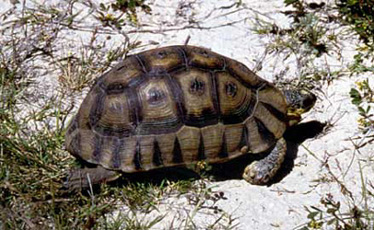South African Bowsprit Tortoise
Category: Turtle

Facts about South African Bowsprit Tortoise. "Scientific name for South African Bowsprit Tortoise Chersina angulata". The South African Bowsprit Tortoise is a Chersina type of tortoise that comes from the Testudinidae family. The South African Bowsprit Tortoises hail from South Africa and are largely found in arid regions and scrub woodland in the country. The South African Bowspirt Tortoise is the only known variety of tortoise in its genus. Usually, the South African Bowsprit Tortoises prefer to live in an area of the Mediterranean and semi-arid climate, with winter-precipitation. However, in this climatic condition, they are tough and extremely flexible varieties of tortoises. In their natural range, the normal predators of the South African Bowsprit Tortoises include jackals, mongoose, baboons, badgers and predatory birds that attack their infants. Maybe their biggest predators in their natural home are the episodic wildfires, which can kill them a huge amount at a time.
Features of South African Bowsprit Tortoise
The South African Bowsprit Tortoise is a little, shy tortoise with comparatively a variable shell, with male tortoises have a maximum carapace length of 11 inches (27.2 cm), with a body mass of 4 1/2 pounds (2.1 kg). The female tortoises are smaller and lighter than the males, with the carapace length of 8 1/2 inches (21.6 cm), and a body mass of 4 pounds (1.8 kg). The South African Bowsprit Tortoise can habitually be differentiated by their famous bowsprits that are projections of the gular guards, from their plastrons beneath their chins. These are employed by male tortoises to fight for females or territory. Uniquely, the South African Bowsprit Tortoise has a single gular shield beneath its chin. The South African Bowsprit Tortoises boast five claws on their forelegs and four claws on each of their back legs. They also have a nuchal scute similar to most other tortoises of south Africa.
There is substantial regional difference in this variety of tortoise. Tortoises that hail from the west shore of South Africa are inclined to have a reddish body color, particularly on the bottom of their shell, whereas the tortoises from the Karoo area are habitually darker, and some are identified to be consistently black. In the eastern part of their range, some tortoises are usually smaller and boast a lighter color. However, in all populations, the South African Bowsprit Tortoises are inclined to assume a consistent brown color in their old age.
The South African Bowsprit Tortoise demonstrates substantial dissimilarity between females and males. The male tortoise is inclined to be bigger, and have a bowl-shaped belly and boast a thinner, longer, peanut form. They also encompass extended and enlarged gular scutes beneath their chins that they exploit for infighting with each other. The female tortoises are inclined to be rounder and smaller, with an even or somewhat u-shaped belly.
The lower shell of the South African Bowsprit Tortoise is yellow to reddish in color, with a broad black mark down their center body. Usually, the South African Bowsprit Tortoises have a black-colored head, habitually with yellow color on the top. Their jaws are feebly serrated, and their upper jaw is curved. They have brown or yellow color limbs, with toes equipped with strong claws.
Diet of South African Bowsprit Tortoise
In the wild, the South African Bowsprit Tortoise feeds on an extensive variety of native plants of South Africa, in addition to mushrooms, mosses, insects, animal faeces and snail shells. In the captive, they are provided with a considerable warm, arid area and fed with an extensive range of ripe plants. South African Bowsprit Tortoise have a unique way of drinking water from small pools, they dip in their face in the water and suck it up through the nose.
Reproduction of South African Bowsprit Tortoise
Mating season in South African Bowsprit Tortoise breeds starts in September and continues until April. Both male and female tortoises obtain the sexual maturity after 10 years of their birth. The male South African Bowsprit Tortoise may chase and bite at the tail and legs of the female tortoise during mating. When the occasion comes to nest, the female tortoise excavates a hole, with the maximum depth of 4 inches (10 cm), into which it will lay only one oval-shaped egg. Each female South African Bowsprit Tortoise can potentially lay eggs at a maximum frequency of six times in a year. Usually, the gestation period ranges from 4 to 14 months. When the eggs hatched, juveniles will appear with a flattened shell length of (1 1/2) 4 cm.
The average lifespan of the South African Bowsprit Tortoise is more than 30 years.

 Back To Category Turtle
Back To Category Turtle